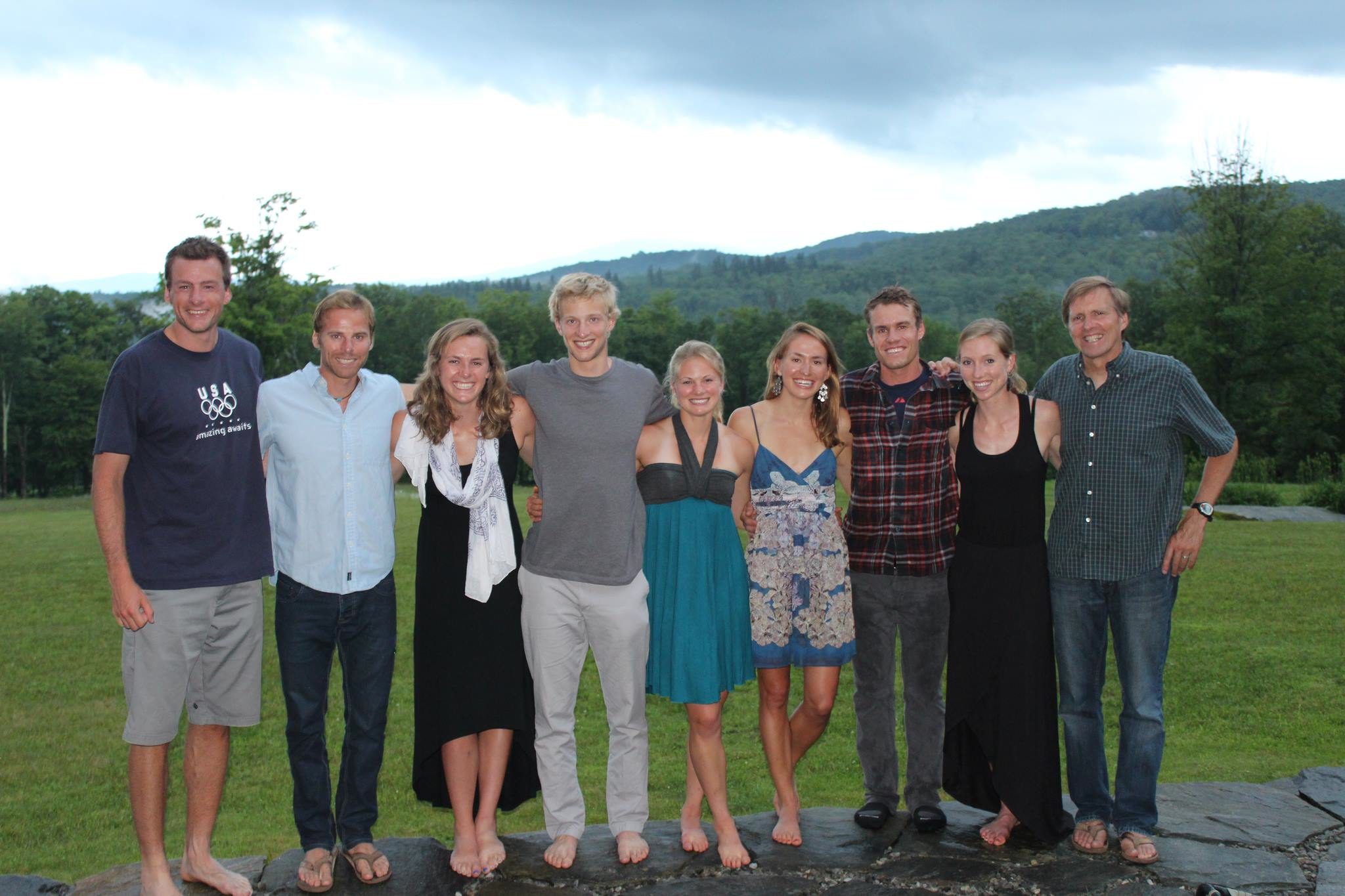
Note: This article has been updated to clarify that Kikkan Randall and Sophie Caldwell became the first two U.S. women to share a World Cup podium at a skate sprint in Lahti, Finland.
Two years ago, no one had ever heard of the Stratton Mountain School T2 Team, not even Stratton’s nordic director, Sverre Caldwell. It didn’t exist.
But the premise of bringing Stratton to the next level of development with its own elite-nordic team was in full swing — Caldwell had hired Gus Kaeding, the former head coach at Central Cross Country (CXC), to lead the six-skier squad, which started out with three then-U.S. Ski Team members (Andy Newell, Jessie Diggins and Skyler Davis) and three Dartmouth grads (Sophie Caldwell, Erika Flowers and Eric Packer).
Sophie Caldwell, Newell and Davis were local Vermonters, and so was Kaeding; he grew up with Newell. It was a team chemistry that was destined for success, at least the way Sverre Caldwell saw it.
Later in the summer of 2012, Stratton landed the T2 Foundation as its title sponsor to meet many of the team’s financial needs. That money went directly to its elite athletes and their expenses, leaving Caldwell to continue seeking for ways to pay his staff members, including Kaeding. Like most nordic teams in the U.S., finances were always a tricky part of the puzzle, but Caldwell assumed that responsibility, leaving the coaching to Kaeding.

For two seasons, the arrangement evolved into something Caldwell never expected. In the spring of 2013, his daughter Sophie was named to the U.S. Ski Team (USST). Diggins was promoted to the A-team, to which Newell also belonged, and another USST member Simi Hamilton joined the Stratton squad.
Suddenly, SMST2 was a powerhouse in the East, with Hamilton winning a sprint stage in the 2013/2014 Tour de Ski, Newell being one of the top-ranked sprinters in the world, and Diggins and Sophie notching consistent top 20’s on the World Cup.
All four went to the Olympics, where Sophie rose to sixth in the skate sprint — the best-ever Olympic finish by a U.S. female nordic skier. When the World Cup resumed again in March, Sophie and Kikkan Randall stood on the Lahti skate-sprint podium together for the first women’s double podium in U.S. cross-country history (Randall won and Sophie was a career-best third).
Caldwell remembered one of the season highlights, in which all four SMST2 skiers made the heats in the Tour de Ski sprint in Lenzerheide, Switzerland. Hamilton went on to win it — a first for a U.S. male — Sophie made the finals for the first time to notch sixth, Newell placed eighth, and Diggins finished 21st.
“Here we are in this little po-town southern Vermont and we have three skiers in the top 10 in the world,” Caldwell said during an interview in Anchorage, Alaska, where the U.S. season-ending races were held two weeks ago.
“I think it attests to the point how well this club model is starting to work,” he added. “APU [Alaska Pacific University] is doing it and we’re doing it and there are all these other programs that are nipping at our heels and trying to do it. Hopefully we have five or six programs that have athletes that are going to the World Cup and being successful.”
Kaeding’s Decision
In the program’s third season, Stratton has been dealt somewhat of a massive blow. Kaeding recently decided to leave the team to pursue a business degree — a career shift he told Caldwell about earlier this year when he was first considering it.
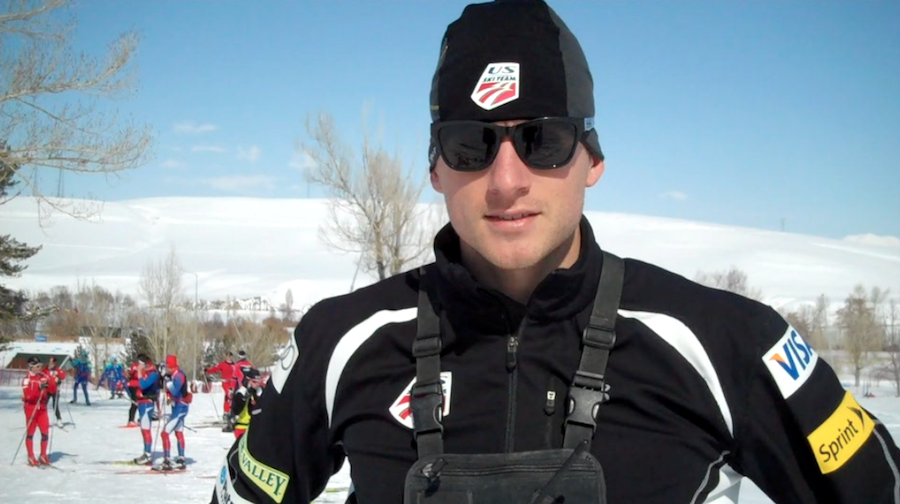
“I realized in ten years I didn’t want to be ski coaching,” Kaeding, 29, said while also in Anchorage at SuperTour Finals and U.S. Distance Nationals. “That may not be the case next year, but if I don’t want to do it in ten years, why would I want to do it next year? That’s just the way my mind works.”
When the thought popped into his mind, he turned to Caldwell, his high-school coach.
“His advice was, is if your heart’s not totally it in then you shouldn’t do it longer,” Kaeding said.
“I kept hoping he’d change his mind,” Caldwell said with a laugh. “That was a really comfortable fit in that … we had the same training philosophy and stuff like that. He was someone I could very easily step back and not mettle with and just do the behind-the-scenes stuff and let him do the coaching. He did a great job and obviously he’s gonna be missed.”
Not one for fanfare or farewells, Kaeding kept his decision in February between him and Caldwell, waiting until after the Olympics to tell the team via email. Some of his athletes were with him at the time in Switzerland, but he explained it was the best way to let everyone know simultaneously.
“I just wanted to treat it as not a big deal,” Kaeding said. “I got a really nice email back from Andy [Newell]. We’ve always been friends, but we almost never really talk that much. … When we come together, we’re just friends. Anytime there’s any separate correspondence, it’s either something’s wrong or something really good happened. So he sent me back a really nice email and said he supported the decision and was happy for me.”
On March 13, Caldwell wrote a blog thanking Kaeding for leading the team for two years. “His dedication and coaching have been outstanding,” the post read. “We are in the process of reviewing everything and discussing how to make the team better than ever and we will continue to flourish. Gus, THANK YOU, and good luck with your future endeavors!”
Specifically, Kaeding plans to apply to business school in the next six months and is interested in specializing in finance. First he’ll see out his contract with Stratton through the end of June, helping a new coach — which he expects will be hired by May — transition over the next few months.
“I haven’t made any decisions where I’d like to go yet,” Kaeding explained. “I’ll educate myself about the process a little more over the coming months and that should shed some light on destinations.”
One area he was considering was Boston. His brother, six years younger, was recently accepted into a master’s program in biomechanical engineering there.
“Now people think that he’s the smarter brother, which is not that case, so I can’t have that,” Kaeding said. “Since I went away to school when I was 15, we’ve really never been around each other that much. I’m closer to him in Vermont, but I still almost never see him. So I’ve tossed around the idea of going to live with him for a little bit in Boston.”
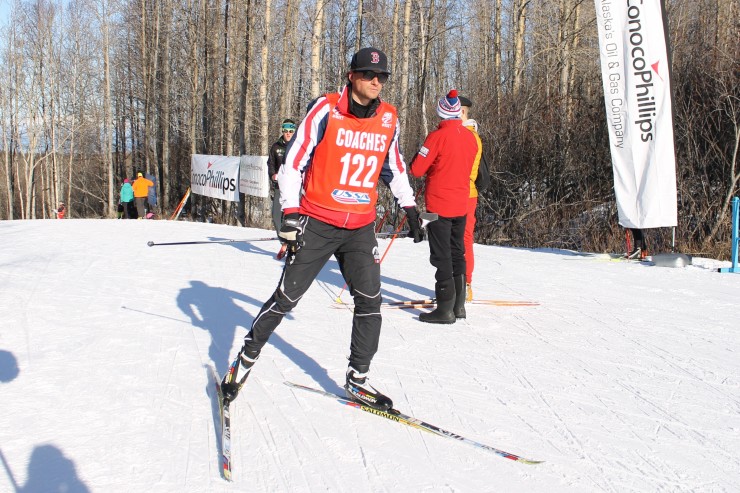
A native of Worcester, Vt., Kaeding explained that he could very well end up in Vermont, but “I’m not gonna live at my parents’ house. … I’d like to be around a few more people I think.”
As for what prompted the move, Kaeding said he was looking for a new challenge after the Olympics, and he wasn’t sure he was ready to coach at the next level.
“When I started the team, Andy was one of my best friends — still is — and one of my personal biggest motivators was to help him do well at this Olympics,” he said. “As the team grew and I got close to everyone … it was to help a number of people really do well at the Olympics. I’m pretty confident we prepared everyone just about as well as we could have for the Olympics.”
As the 2014 Winter Games got closer, Kaeding wondered what was next.
“There were other things that were really exciting for me and also, ski coaching is really hard,” he said with a laugh. “Especially if you want to do it really, really well. Not that I do it really, really well — I think that if I want to take that next step, it’s a full commitment. I definitely work every day.”
Those days are long, and while he couldn’t explain what exactly it was that takes its toll, “there’s lots of days when I get back from coaching and I haven’t really worked that hard, I haven’t thought about anything that much, I haven’t skied that much, but you’re so drained. Maybe it’s just focusing all day, but you get back and the only thing you want to do is stare at the wall or zone out doing nothing.”
At this point, Kaeding would like to challenge himself in a different, more academic way. A math major at Northern Michigan University — not because he liked math but because it came easy to him — Kaeding said his undergraduate experience was mostly about ski racing.
“Being in college and focused on skiing it’s a different way of going to college than a lot of people do it,” he said. “I wouldn’t mind going back to graduate school. I still like numbers. One of my hobbies is the stock market. I realize that it would be hard after this to sit at a desk for hours and hours, but the prospect of doing something that’s challenging for my mind more than my body is enticing.”
The Coaching Pipeline
For a 29-year-old coach of one of the most successful clubs in the U.S., a job with the U.S. Ski Team might not have been too far fetched. Kaeding said the possibility of joining those ranks crossed his mind, but he also realized how hard the national-team coaches worked.
“I saw what those guys did, and I thought maybe I could make something almost similar but better at Stratton,” he said. “This club model that we have going is really good … The four coaches on the U.S. Ski Team are probably the best coaches in the country and that’s why they’re there, but I almost think the less they do, the better. Just because they’re so far removed during the summer from a lot of these athletes, because of the geography of the country, because they have their own lives, too.”
Kaeding liked the club model because it allowed teammates to stick together and be competitive with one another, making physical gains as if they were training year-round with their USST teammates, which many of them were.
“I envisioned that happening at SMS, but maybe I just can’t quite wait for that,” Kaeding added. “It might be a little longer. I think we got a good start on it.”
He said he’s received “nothing but support,” regarding his decision, including U.S. coach Matt Whitcomb suggesting he pursue whatever made him happy.
“That was always nice to hear from someone in his position,” Kaeding said.
As for Stratton, he’s confident the team will carry on as usual, reaching higher levels of success in the coming seasons.
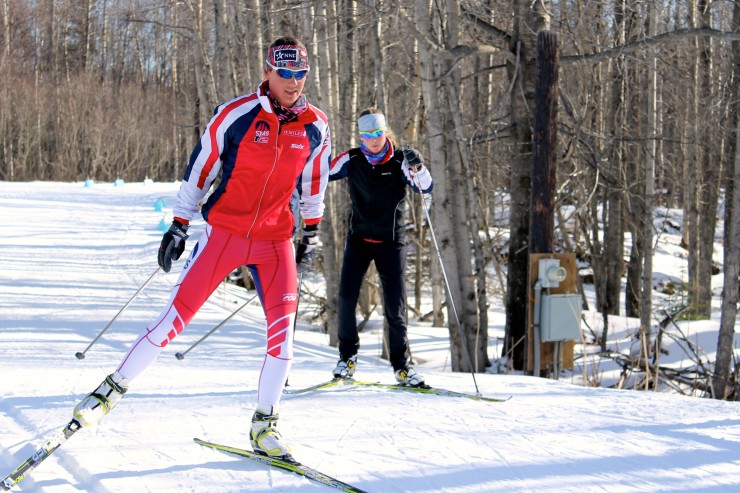
“I think we hold our athletes responsible to themselves more than other clubs or teams,” Kaeding said. “Stupid little things: they wax their own skis lots of times, but also I encourage them to almost be able to write their own training plans so that they’re cognizant of how they’re feeling day to day.
“They’re all pretty mature and they can all basically write their own training plans so they would be OK, I think, completely on their own,” he explained.
“That being said, the group dynamic is one of our strengths, and I just think when a new coach comes in, it won’t be that hard. He or she will be able to sit back and learn from them for a while and see where she or he is needed. That’s all I kind of did anyway.”
Caldwell posted the job opening last week, and said he was looking to hire by early April — end of June at the latest. He’ll continue to oversee Stratton’s various nordic programs as director, and hopes he won’t have to take too much time away from helping his younger skiers if they can’t get a replacement in time. Matt Boobar currently coaches the older boys, Chase Marston assists Caldwell with the girls team, and Poppet Boswell coaches the younger juniors.
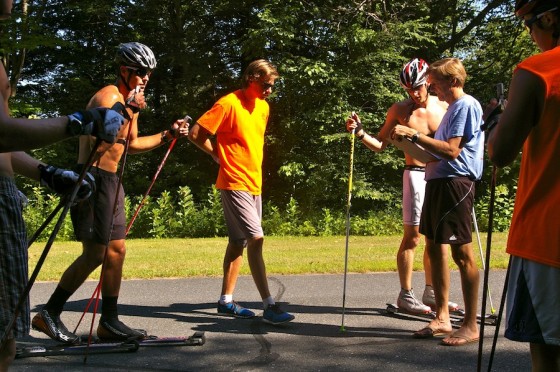
“If I can hire a new person, it would be really important for Gus to talk to the new coach,” Caldwell said. “You just want everything to be logical progression. It’s nice that he’s fading out, but he’s still available.
“We have a great group and we’ll be great moving ahead,” he added. “When I talk to people I’m going to be talking about their philosophy of training and stuff like that, and I assured athletes the same deal, I said it’s going to be a variation in a theme, it’s not going to be something totally new or take you two years to get used to.”
In terms of interest, Caldwell said a couple weeks ago he had no idea what he would get for applications. A few people inquired when he posted the blog about Kaeding, but he wanted to get through the season and talk to his athletes before creating a job description and setting up interviews.
“The only thing that’s really gonna change is the person that’s there,” Caldwell explained. “Obviously it sucks, but I don’t think it’s gonna kill us or anything, it’s just we have to find someone else. The whole outline of what we’re trying to do remains the same and the athletes understand that.”
The Bigger Picture
Reflecting on his coaching career, Kaeding said there were a lot of highlights, but he considers the thriving club model to be the best of them.
“Even going back to CXC, we were really successful there, then really successful at SMS,” he said. “I’ve heard blowings in the wind of a lot of other clubs sprouting up now. I think they said, ‘They did it, we can figure out how to do it. We’ve got to get creative.’ We got creative.
“At some point we’re going to hit a threshold where there’s too many clubs, and sooner or later, that’ll even out. There will be too many clubs and one year there will be three going under. Then it’ll come back. I mean it’s good for sure. More competition’s always good.”
Those supply-and-demand aspects of developing U.S. skiing still interest Kaeding and remain something he could see himself delving into.
“I think there’s a lot of things out there in nordic skiing that there’s just no one doing because it’s not worth their time,” he said. “I don’t know how USSA works … I don’t know how things are marketed … I’d like to go to school a little bit more to learn if it’s conceivable to push nordic skiing into another realm from kind of a different perspective.
“It’s easy to say, ‘Coach, coach, coach and the athletes will get better,’ but I don’t really see anyone attacking it from the business side,” he added. “I can say that now; I don’t know if I’d actually do that, but it’s probably a pretty good angle to get into business school at the very least.”
Alex Kochon
Alex Kochon (alexkochon@gmail.com) is a former FasterSkier editor and roving reporter who never really lost touch with the nordic scene. A freelance writer, editor, and outdoor-loving mom of two, she lives in northeastern New York and enjoys adventuring in the Adirondacks. She shares her passion for sports and recreation as the co-founder of "Ride On! Mountain Bike Trail Guide" and a sales and content contributor at Curated.com. When she's not skiing or chasing her kids around, Alex assists authors as a production and marketing coordinator for iPub Global Connection.




2 comments
bigbeef
April 8, 2014 at 8:27 pm
Good article, but I have to point out the Author’s ignorance: Sophie C. and Kikaan Randall’s podium in Lahti was not the “first double podium in U.S. cross-country history.” It was the first ever WOMEN’s U.S. double WC podium. Bill Koch led American men to double WC podiums MULTIPLE times back in the golden age of U.S. nordic skiing. A world cup is a World Cup, and Lahti 2014 is no more special than Falun in 1982 or even our own Kincaid Park in 1983. They were all World Cups, they all count as World Cups and more importantly there were always two U.S. skiers on the podium. Let’s keep respect for the best athletes in U.S. xc ski history and not let our ignorance discount their past successes.
http://data.fis-ski.com/dynamic/results.html?sector=CC&competitorid=31319&raceid=1809
teamepokeedsbyn
April 8, 2014 at 9:22 pm
I would venture to guess that Koch, TC, and JimG et al would not take offense to the slight. That said, IMO, a podium in a 1-3 minute sprint race is just less impressive than one run over many hills and dale over 3 or (many) more miles. Sort of like sprint stages in bike stage races – really just those that can win over brutal rugged courses with tough climbs and descents become legend. What the men’s “putney” crew did those years ago was stunning, given the odds (and undetectable drugs) they were up against.